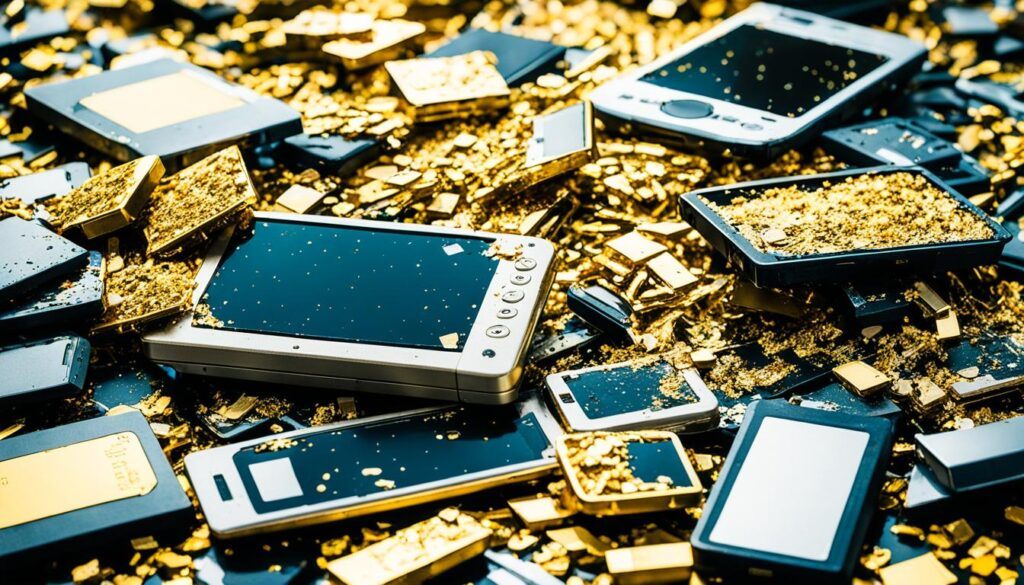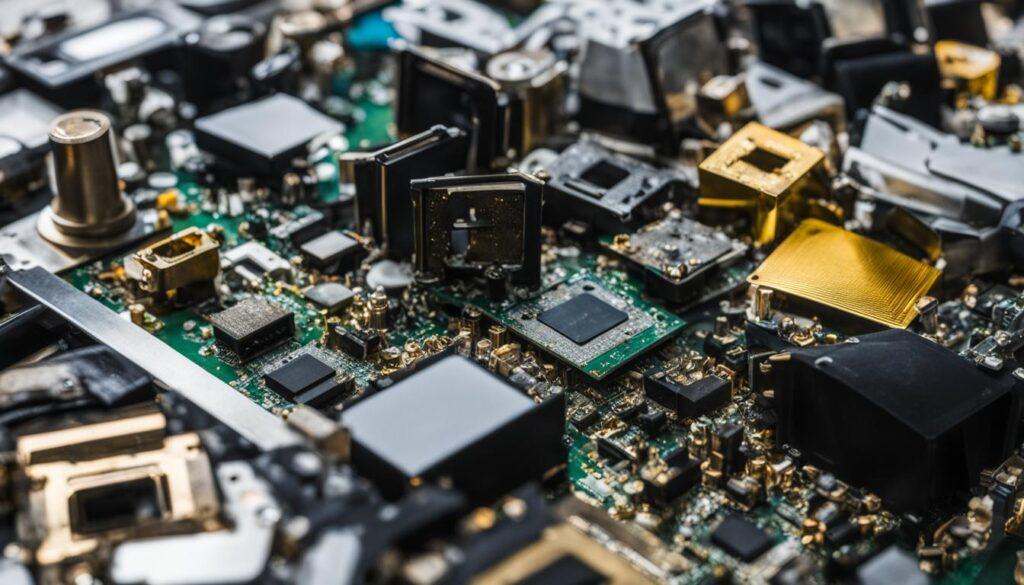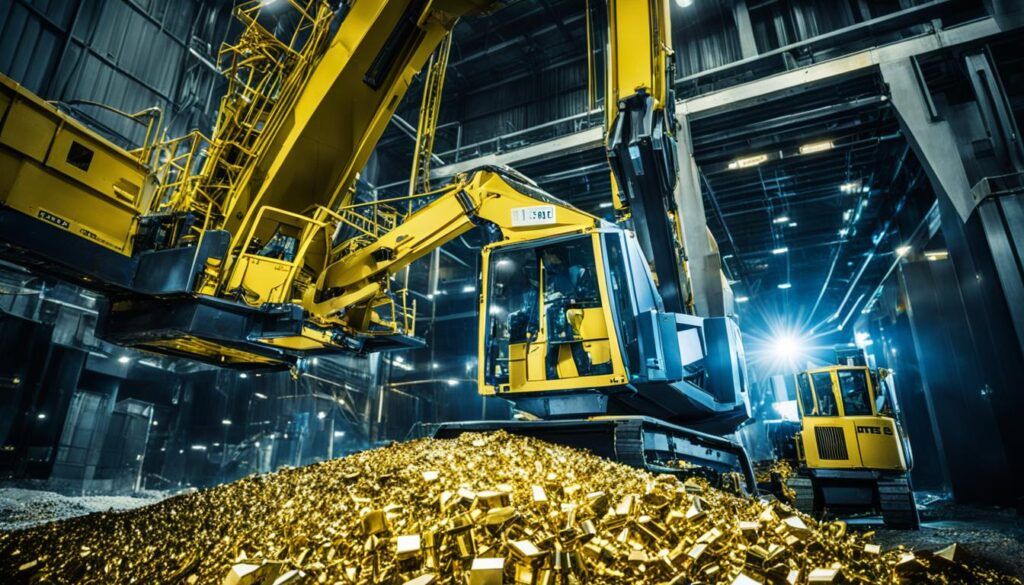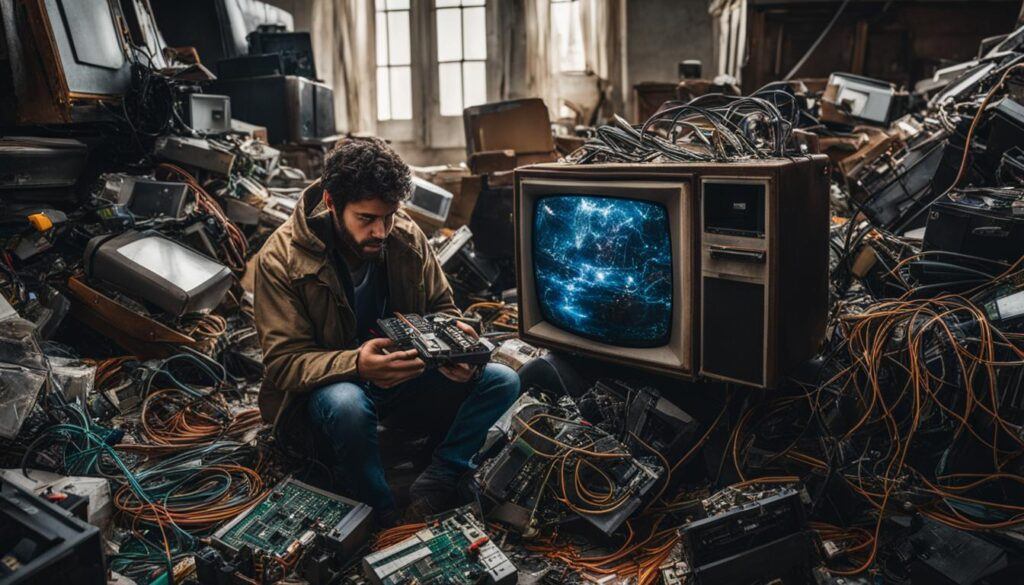When it comes to the question of how much gold is in a TV, the answer may surprise you. While there is indeed gold present in electronic devices like TVs, the amount is relatively small and not worth the effort and cost of extraction for individual consumers. In this article, I will delve into the intricacies of gold content in TVs, TV gold recovery, and the challenges of extracting gold from old TVs.
Key Takeaways:
- The gold content in a single flat-screen TV is only about 20 to 60 cents, making it economically impractical to extract for most individuals.
- Industrial operations use specialized scraping machines to efficiently reclaim tons of scrap containing gold and other precious metals from electronic devices.
- While TVs do contain some gold, the amount is small and not significant compared to other electronic devices like circuit boards.
- Extracting gold from TVs requires specialized knowledge, equipment, and the use of potentially harmful chemicals, making it a complex and hazardous process.
- The future of gold supply lies in recycling old products, including TVs, to reduce the need for new mining and minimize environmental impact.
How Much Metal Value Is in a TV?
When it comes to the metal value in a TV, it’s important to understand that the amount is relatively low. Cheap televisions typically contain less valuable metals, such as aluminum, copper, and steel. While these metals have their uses, they don’t hold significant value in terms of extracting and recycling them from TVs.
The weight of the metal components in a TV is considerably less than the cost of a brand new TV. For example, a 40″+ LCD HDTV usually has a scrap value lower than $276. This value encompasses the various metals present in the TV, including copper, aluminum, and steel. However, the gold content in TVs is minimal, which further diminishes the overall metal value.
Extracting gold from a TV can be time-consuming and may involve the use of harmful chemicals. Although gold is a relatively valuable metal, the quantity found in TVs is not significant enough to justify the effort and resources required for extraction. The process of extracting gold from electronic devices can be complex and demanding, with potentially hazardous consequences.
In summary, while a TV may contain a variety of metals, including aluminum, copper, steel, and small amounts of gold, the overall value of these metals is not significant. Extracting and recycling the metal content from a TV is often not worth the effort and potential risks involved.
| Metal | Approximate Value |
|---|---|
| Aluminum | Low |
| Copper | Low to moderate |
| Steel | Low |
| Gold | Minimal |
Gold Content in TVs
When it comes to the gold content in TVs, it is important to note that while there is some gold present, the amount is relatively small and not significant. The gold is primarily found in the circuit boards and connectors of older TVs.
Manufacturers have been conscious of cost considerations and therefore used as little gold as possible in the construction of TVs. This means that the gold content in a TV is minimal compared to other electronic devices. The focus is more on using copper and gold in the building of devices like TVs to facilitate efficient transmission and conductivity.
Recovering gold from a TV can be a challenging process that might require specialized knowledge and equipment. Additionally, the extraction process may involve the use of harmful chemicals, which poses safety and environmental concerns.
In my opinion, dismantling a TV for its gold content is not recommended as the effort and associated risks outweigh the potential value of the gold recovered.
If we consider the value of the gold obtained and compare it to the effort and cost involved in the extraction process, the return on investment is not favorable. It is more efficient and practical to pursue other avenues for gold extraction, such as from electronic waste sources that have a higher gold concentration.
Gold Content in Circuit Boards
When it comes to circuit boards, they do contain a higher concentration of gold compared to other parts of a TV. The gold in circuit boards is often used for its superior conductivity and corrosion resistance properties. However, the amount of gold in each individual board is still relatively small.
To put it into perspective, to extract a significant amount of gold from circuit boards, a considerable number of boards would be required. This reinforces the fact that extracting gold from TVs is not an efficient way to obtain this precious metal.
| Component | Gold Content |
|---|---|
| Circuit Boards | Small amount of gold per board |
| Connectors | Small amount of gold per connector |
Overall, while it is true that TVs contain some gold, the amount is not substantial enough to make gold extraction from these devices a viable option. It is more practical to focus on other sources of gold and electronic waste recycling to obtain this precious metal efficiently.
Extracting Gold from TVs
While extracting gold from TVs is technically possible, it is not a practical endeavor for individual consumers. The process of extracting gold from electronic devices like TVs requires specialized knowledge, equipment, and the use of potentially hazardous chemicals. Additionally, the gold content in a TV is minimal, making the effort and cost involved in the extraction process outweigh the potential value of the gold recovered.
Instead, a more efficient and environmentally friendly approach is to recycle old TVs through proper channels. TV recycling ensures that valuable materials can be recovered and reused in the manufacturing of new products, including TVs themselves. By recycling old TVs, we not only conserve resources but also minimize electronic waste and reduce the need for new mining operations.
If you’re considering recycling your old TV, it is essential to find authorized recycling centers or professional recyclers who use safe and responsible recycling practices.
Benefits of Recycling TVs
Recycling old TVs offers several benefits:
- Promotes resource conservation by reusing valuable materials like gold, copper, and aluminum
- Reduces electronic waste and prevents hazardous materials from entering landfills
- Minimizes the need for new mining operations, which can have significant environmental impacts
- Supports the development of a circular economy, where products and materials are recycled and reused rather than discarded
By responsibly recycling our old TVs, we contribute to a more sustainable future and help protect the environment.
| Method | Pros | Cons |
|---|---|---|
| TV Gold Extraction | – Technically possible – Gold can be recovered |
– Requires specialized knowledge and equipment – Use of hazardous chemicals – Minimal gold content in a TV – Effort and cost outweigh potential value – Not recommended for individual consumers |
| TV Recycling | – Efficient and environmentally friendly – Recovery of valuable materials – Conservation of resources – Reduction of electronic waste |
– Requires finding authorized recycling centers – Lack of monetary value for individual consumers |
Based on the comparison above, it is clear that recycling old TVs is a more viable option for both individuals and the environment.

Environmental Impact of TV Recycling
Properly recycling old TVs is essential to minimize their environmental impact. TVs and other electronic devices contain hazardous materials that can harm the environment if not disposed of correctly. Recycling TVs not only helps to mitigate these environmental risks but also offers various other benefits.
One significant advantage of recycling is the recovery of valuable materials like gold, copper, and aluminum. These resources can be extracted from old TVs and reused in the manufacturing of new products, reducing the need for mining raw materials. By recycling TVs, we can conserve natural resources and minimize the environmental impact associated with the extraction and production of these materials.
Furthermore, recycling TVs helps to prevent the accumulation of electronic waste in landfills. Electronic waste, or e-waste, poses significant environmental and health risks due to the presence of toxic substances such as lead, mercury, and brominated flame retardants. When TVs end up in landfills, these harmful chemicals can leach into the soil and contaminate nearby water sources, causing pollution and endangering ecosystems.
By recycling old TVs instead of disposing of them in landfills, we can reduce the amount of e-waste and prevent the release of these hazardous substances into the environment. Recycling facilities are equipped to handle and safely dispose of electronic waste, ensuring that the harmful materials are properly contained and treated.
Furthermore, recycling TVs helps to reduce the energy and resource consumption associated with manufacturing new devices. The extraction of raw materials, such as gold and copper, requires significant energy and often involves destructive mining practices. By reusing these materials through recycling, we can conserve energy, reduce greenhouse gas emissions, and minimize the environmental footprint of the electronics industry.
“Recycling one million laptops saves the energy equivalent to the electricity used by more than 3,500 U.S. homes in a year.”
Overall, proper TV recycling plays a crucial role in safeguarding the environment. By recovering valuable materials, preventing electronic waste from entering landfills, and reducing resource consumption, we can contribute to a more sustainable and responsible approach to electronic waste disposal.
Value of TV Scrap Materials
When it comes to the value of scrap materials in a TV, several factors come into play, including the specific components and the current market prices for metals like copper, aluminum, and steel. The overall value of scrap materials in a TV tends to be relatively low. However, some companies are still willing to pay a few dollars for scrap TVs in order to reclaim the valuable materials.
If you’re considering selling your TV for scrap, keep in mind that the monetary return is unlikely to be significant. While selling your TV in bulk to a scrap dealer may yield a small amount of money, it’s important to set realistic expectations. The value of the scrap materials in a TV alone may not be enough to make a substantial profit.
Here is an estimate of the potential scrap value for individual metal components found in TVs:
| Metal Component | Estimated Scrap Value (per pound) |
|---|---|
| Copper | $2.50 – $3.50 |
| Aluminum | $0.50 – $1.00 |
| Steel | $0.05 – $0.10 |

In the current market, the scrap value of these metals fluctuates depending on supply and demand. It’s important to note that these prices are subject to change and may vary in different locations. Additionally, the weight and quality of the components in your specific TV will determine the final scrap value.
“Selling your TV for scrap can be a convenient way to dispose of it while potentially making a small amount of money. However, it’s crucial to keep in mind that the value of the scrap materials alone may not justify the effort for most individuals.”
Ultimately, if you’re looking for a significant monetary return, selling your TV for scrap may not be the most effective option. Instead, consider recycling your TV through authorized channels to ensure the responsible disposal of electronic waste and the recovery of valuable materials.
Reclaiming Precious Metals from TVs
Large-scale operations have the capability to reclaim precious metals, such as gold, from TVs and other electronic devices. These operations utilize specialized machinery that efficiently separates and extracts valuable materials from tons of scrap metal each hour.
However, it is important to note that individual consumers or small-scale operations are unlikely to profit from reclaiming precious metals from TVs. The concentration of gold in a single TV is relatively low, and the cost involved in the extraction process outweighs the potential value of the gold recovered.
While large-scale operations can achieve efficient and cost-effective precious metal recovery, it is not a viable option for individuals or small-scale enterprises looking to obtain significant profits from TV scrap metal reclamation.
If you are interested in understanding the process of gold recovery in more detail, the following table provides an overview of the typical gold recovery process:
| Gold Recovery Process | Description |
|---|---|
| 1. Dismantling | TVs are dismantled to access the internal components, such as circuit boards. |
| 2. Crushing | The electronic waste is crushed into small particles, increasing the surface area for chemical reactions. |
| 3. Chemical Leaching | A chemical solution is used to leach out the precious metals, separating them from other materials. |
| 4. Metal Recovery | The precious metals are recovered from the leach solution through various processes, such as precipitation or electroplating. |
| 5. Refining | The recovered precious metals undergo further purification and refining to obtain high-purity gold or other valuable metals. |
It’s important to note that the gold recovery process involves the use of chemicals, which can be hazardous if not handled properly. Therefore, it is recommended to leave the precious metal recovery process to professionals who have the necessary knowledge and equipment.
Please refer to the image below for an illustration of the gold recovery process:
Reclaiming precious metals from TVs can be a complex and resource-intensive endeavor. As an individual or small-scale operation, it is more practical and environmentally responsible to recycle old TVs through authorized channels. This ensures the recovery of valuable materials and minimizes the environmental impact of electronic waste disposal.
The Future of Gold Mining and Recycling
As the known gold deposits continue to diminish, the future of gold mining lies in the sustainable practice of recycling. Industries are recognizing the importance of reclaiming and recycling gold from old products, including TVs, to meet their gold supply needs. This shift towards gold recycling is not only driven by the depletion of gold reserves but also by the desire to minimize the environmental impact of gold extraction.
By embracing gold recycling, industries can reduce the demand for new mining operations, which often result in habitat destruction, water pollution, and other ecological consequences. Sustainable gold extraction methods are being developed to optimize the recovery and utilization of gold from electronic waste, ensuring a more responsible and environmentally friendly approach.
The gold recycling industry is continually evolving, with advancements in technology making the extraction process more efficient and cost-effective. These innovations enable the extraction of even trace amounts of gold from TVs and other electronic devices, contributing to the overall gold supply chain.
The table below provides a comparison between traditional gold mining and sustainable gold recycling:
| Traditional Gold Mining | Gold Recycling | |
|---|---|---|
| Environmental Impact | Significant habitat destruction and pollution | Reduces the need for new mining, minimizes ecological consequences |
| Economic Efficiency | Expensive and resource-intensive process | Cost-effective method utilizing existing resources |
| Resource Depletion | Depletes finite gold reserves | Conserves precious metal resources |
Through sustainable gold recycling, the industry is moving towards a circular economy, where valuable resources are recycled and reused instead of being discarded as waste. This approach not only conserves resources and reduces the need for new mining but also promotes a more sustainable and responsible gold supply chain.
The Benefits of Sustainable Gold Recycling
- Conservation of finite gold reserves
- Reduction in the environmental impact of gold extraction
- Optimization of resource utilization through recycling
- Promotion of a circular economy and the responsible use of resources
By embracing sustainable gold extraction methods and promoting the recycling of gold from electronic waste, the future of gold mining can become more environmentally conscious and economically viable.

The Value of Recycling TVs
Recycling old TVs goes beyond the potential recovery of precious metals. It plays a vital role in safeguarding our environment and promoting responsible e-waste disposal. By recycling TVs, we prevent the release of hazardous materials into landfills and reduce the need for mining raw materials. This effort contributes to the conservation of resources and supports the development of a circular economy.
Proper TV recycling has numerous benefits, both for the environment and for society as a whole. Let’s explore these benefits further:
Environmental Benefits of TV Recycling
- Reduces e-waste: TVs contain hazardous materials that can harm the environment if not disposed of properly. Recycling ensures these materials are safely handled and prevents them from polluting our land and water sources.
- Conserves resources: By recycling TVs, we recover valuable materials like gold, copper, and aluminum, which can be reused in the manufacturing of new products. This reduces the need for mining raw materials, conserving natural resources.
- Reduces energy consumption: Recycling old TVs requires less energy than producing new ones from raw materials. This helps lower greenhouse gas emissions and contributes to a more sustainable future.
- Prevents landfill accumulation: Electronic waste, including TVs, can quickly accumulate in landfills. By recycling these devices, we reduce the volume of waste being deposited in landfills and promote a cleaner and healthier environment.
Responsible E-waste Disposal
“Recycling old TVs is not just about the value of the materials inside; it’s about taking responsibility for our electronic waste and making a positive impact on the environment. By properly disposing of our TVs, we ensure that their valuable components can be recovered and reused, reducing the need for new resource extraction and minimizing the environmental footprint of our electronic devices.”
Recycling old TVs is a simple yet effective way to contribute to a more sustainable future. By adopting responsible e-waste disposal practices, we can make a significant difference in reducing environmental impact and conserving valuable resources.
| Benefit | Description |
|---|---|
| Reduces e-waste | Prevents hazardous materials from polluting the environment |
| Conserves resources | Reclaims valuable materials for reuse, reducing the need for raw material extraction |
| Reduces energy consumption | Requires less energy than producing new TVs |
| Prevents landfill accumulation | Reduces the volume of electronic waste in landfills |
The Challenges of DIY TV Scraping
Dismantling a TV for its scrap materials can be a daunting task, filled with various challenges and potential dangers. If you’re considering DIY TV recycling, it’s important to be aware of these obstacles before embarking on the process. From the need for specialized tools to safety concerns, there are several factors to consider when dismantling a TV for its scrap metal extraction.
Specialized Tools and Knowledge
DIY TV scraping requires specific tools to effectively disassemble the device and extract the valuable materials. Power drills, wire cutters, and wire strippers are some examples of the tools that may be necessary. Additionally, having knowledge of the internal components of a TV is crucial to navigate through the intricate structure of the device.
Safety Hazards
One of the main challenges of DIY TV scraping is the potential safety hazards involved. Even when unplugged, TVs may still retain electrical charges, which can pose a risk of electric shock if not handled properly. It’s important to exercise caution and follow safety protocols when dismantling a TV to minimize the risk of accidents or injuries.
Harmful Chemicals
The extraction process of valuable metals from TVs may involve the use of harmful chemicals. These chemicals can be hazardous to both human health and the environment if not handled and disposed of correctly. It is essential to have proper knowledge of the chemicals involved and follow the necessary safety guidelines to ensure safe handling and disposal.
Table:
| Challenges of DIY TV Scraping |
|---|
| Need for specialized tools |
| Safety hazards, such as electrical charges |
| Potential exposure to harmful chemicals |

Given these challenges and potential risks, it is generally recommended to leave TV recycling to professionals or authorized recycling centers. These entities have the expertise, experience, and necessary equipment to safely and efficiently handle the dismantling and scrap metal extraction process. By opting for professional assistance, you can ensure the proper disposal of your TV and contribute to a safer and more environmentally friendly recycling process.
The Future of TV Recycling
The future of TV recycling is bright, driven by technological advancements and a growing awareness of the importance of responsible electronics disposal. Innovations in recycling processes are improving the efficiency of extracting valuable materials from TVs, making recycling more economically viable and environmentally sustainable. Additionally, consumer education and extended producer responsibility programs are promoting the proper disposal and recycling of TVs, ensuring that valuable resources are recovered and minimizing the environmental impact of electronic waste.
Technological Advancements in E-Waste Recycling
Technological advancements in e-waste recycling are revolutionizing the industry and paving the way for a more sustainable future. New recycling technologies are being developed that can efficiently recover precious metals, such as gold, silver, and copper, from old TVs and other electronic devices. These advancements increase the efficiency and effectiveness of the recycling process, making it easier to extract valuable materials and reduce the reliance on raw materials.
Sustainable Electronics Disposal
The concept of sustainable electronics disposal encompasses both the responsible disposal of electronic devices and the recycling of valuable materials. It involves minimizing the environmental impact of electronic waste by ensuring that devices are properly recycled and that valuable resources are recovered and reused. Through sustainable electronics disposal practices, we can reduce the amount of electronic waste sent to landfills, conserve natural resources, and mitigate the negative environmental effects associated with the production and disposal of electronics.
“The future of TV recycling is driven by technological advancements in e-waste recycling and increased awareness of the importance of responsible electronics disposal.”
| Benefits of the Future of TV Recycling | Technological Advancements | Sustainable Electronics Disposal |
|---|---|---|
|
|
|
The future of TV recycling holds promise for a more sustainable and responsible approach to electronics disposal. By embracing technological advancements and adopting sustainable practices, we can maximize the recovery of valuable materials, minimize environmental impact, and create a more circular and resource-efficient economy.
Conclusion
In conclusion, the gold content in TVs is minimal, making it not worth extracting for individual consumers. Despite the presence of some gold, the cost and effort involved in the extraction process outweigh the potential value of the gold recovered. Therefore, recycling old TVs through authorized channels is the most responsible and efficient way to dispose of these electronic devices.
By recycling TVs, valuable materials like gold, copper, and aluminum can be recovered and reused in the manufacturing of new products. This not only contributes to the conservation of finite resources but also helps protect the environment by reducing electronic waste. Additionally, recycling supports the development of a circular economy, where resources are reused and recycled to minimize waste and conserve natural resources.
In summary, instead of attempting to extract gold from TVs, it is recommended to take advantage of authorized recycling programs to ensure proper disposal and recovery of valuable materials. This approach not only eliminates the environmental risks associated with extracting gold from electronics but also aligns with the principles of sustainability and responsible waste management.
FAQ
How much gold is in a TV?
The gold content in a TV is relatively low. In a single flat-screen TV, you can find only about 20 cents worth of reclaimable gold. Some TVs may contain up to 60 cents worth of gold.
How much metal value is in a TV?
The metal value in a TV is not significant. Cheap TVs contain less valuable metals such as aluminum, copper, and steel. The weight of the metal components in a TV is significantly less than the cost of a new TV. A 40″+ LCD HDTV usually has a scrap value lower than 6.
What is the gold content in TVs?
The gold content in TVs is minimal. Gold is mainly found in the circuit boards and connectors of older TVs, but manufacturers used as little gold as possible to keep costs down.
How do you extract gold from TVs?
Extracting gold from TVs is possible but not practical for individual consumers. It requires specialized knowledge, equipment, and the use of potentially harmful chemicals. The low concentration of gold in a TV and the cost and effort involved in the extraction process make it inefficient for individual extraction.
What is the environmental impact of TV recycling?
Proper TV recycling is essential to minimize environmental impact. TVs and other electronic devices contain hazardous materials that can harm the environment if not disposed of correctly. Recycling ensures the recovery of valuable materials and prevents the accumulation of electronic waste in landfills.
What is the value of TV scrap materials?
The value of scrap materials in a TV varies depending on the specific components and current market prices for metals like copper, aluminum, and steel. While the overall value may be low, some companies may pay a few dollars for scrap TVs to reclaim valuable materials.
Can precious metals be reclaimed from TVs?
Large-scale operations can reclaim precious metals, including gold, from TVs and other electronic devices. However, individual consumers or small-scale operations are unlikely to profit from reclaiming precious metals due to the low concentration of gold and the cost involved in the extraction process.
What is the future of gold mining and recycling?
As known gold deposits are depleted, industries will increasingly rely on recycling for their gold supply. By reclaiming and recycling gold from electronic waste, industries can reduce the need for new mining and minimize the environmental impact of gold extraction.
What is the value of recycling TVs?
Recycling old TVs helps protect the environment by preventing the release of hazardous materials and reducing electronic waste in landfills. Furthermore, valuable resources like gold, copper, and aluminum can be recovered and reused in the manufacturing of new products, promoting a circular economy.
What are the challenges of DIY TV scraping?
Dismantling a TV for scrap materials can be challenging and potentially dangerous. It requires specialized tools and knowledge of TV internals. DIY TV scraping may pose safety hazards, and the extraction process may involve the use of harmful chemicals. It is recommended to leave TV recycling to professionals or authorized recycling centers.
What is the future of TV recycling?
The future of TV recycling lies in technological advancements and increased awareness of responsible electronics disposal. Innovations in recycling processes can improve efficiency, and consumer education can promote proper disposal and recycling. This ensures valuable resources are recovered, and environmental impact is minimized.



